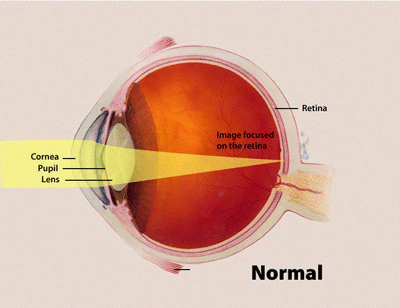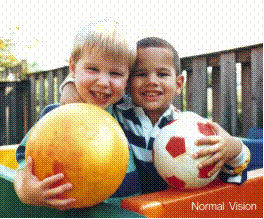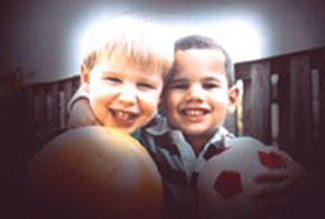Common vision problems
Common vision problems

The cornea and lens bend (refract) incoming light rays so they focus precisely on the retina at the back of the eye.
What is refraction?
Refraction is the bending of light as it passes through one object to another. Vision occurs when light rays are bent (refracted) as they pass through the cornea and the lens. The light is then focused on the retina. The retina converts the light-rays into messages that are sent through the optic nerve to the brain. The brain interprets these messages into the images we see.What are the different types of refractive errors?
The most common types of refractive errors are nearsightedness, farsightedness, astigmatism and presbyopia.Nearsightedness (also called myopia) is a condition where objects up close appear clearly, while objects far away appear blurry. With nearsightedness, light comes to focus in front of the retina instead of on the retina. Learn more about nearsightedness.
Farsightedness (also called hyperopia) is a common type of refractive error where distant objects may be seen more clearly than objects that are near. However, people experience farsightedness differently. Some people may not notice any problems with their vision, especially when they are young. For people with significant farsightedness, vision can be blurry for objects at any distance, near or far. Learn more about farsightedness.
Astigmatism is a condition in which the eye does not focus light evenly onto the retina, the light-sensitive tissue at the back of the eye. This can cause images to appear blurry and stretched out. Learn more about astigmatism.
Presbyopia is an age-related condition in which the ability to focus up close becomes more difficult. As the eye ages, the lens can no longer change shape enough to allow the eye to focus close objects clearly. Learn more about presbyopia.
Who is at risk for refractive errors?
Presbyopia affects most adults over age 35. Other refractive errors can affect both children and adults. Individuals that have parents with certain refractive errors may be more likely to get one or more refractive errors.What are the signs and symptoms of refractive errors?
Blurred vision is the most common symptom of refractive errors. Other symptoms may include:- Double vision
- Haziness
- Glare or halos around bright lights
- Squinting
- Headaches
- Eye strain
How are refractive errors diagnosed?
An eye care professional can diagnose refractive errors during a comprehensive dilated eye examination. People with a refractive error often visit their eye care professional with complaints of visual discomfort or blurred vision. However, some people don’t know they aren’t seeing as clearly as they could.How are refractive errors corrected?
Refractive errors can be corrected with eyeglasses, contact lenses, or surgery.Types of Vision Problems
Most Common Adult Vision Problems
- Blurred vision (called refractive errors)
- Age-related macular degeneration
- Glaucoma
- Cataract
- Diabetic retinopathy
Most Common Childhood Vision Problems
- Blurred vision (called refractive errors)
- Crossed eyes (called strabismus)
- Lazy eye (called amblyopia)
Blurred vision (refractive errors)
- Nearsightedness (called myopia) is when you can see clearly up close but blurry in the distance.
- Farsightedness (called hyperopia) is when you can see clearly in the distance but blurry up close.
- If you are older than 40 and have trouble reading small print or focusing up close, this is usually due to a condition called presbyopia. One in every three people 40 years or older in the U.S. will need glasses to read smaller print.
- Astigmatism is another condition that causes blurred vision, but it is because of the shape of the cornea.
What are the risk factors for developing refractive errors?
- Family history – parent(s) who have one or more refractive errors
- Advancing age - presbyopia affects most adults over age 35
Crossed Eyes (strabismus)
Strabismus occurs when the eyes do not line up or they are crossed. One eye, however, usually remains straight at any given time. Common forms of strabismus include:- Esotropia – one or both eyes turn inward toward the nose
- Exotropia – one or both eyes turn out; also called wall-eyed
- Hypertropia – one or both eyes turn up
- Hypotropia – one or both eyes turn down
If left untreated strabismus can cause amblyopia.
What are the risk factors for strabismus?
- Family history of strabismus
- Having a significant amount of uncorrected farsightedness (hyperopia)
- Disabilities such as Down syndrome and cerebral palsy
- Stroke or head injury
Lazy Eye (amblyopia)
Amblyopia — often called lazy eye — is a problem that is common in children.Amblyopia is a result of the brain and the eyes not working together. The brain ignores visual information from one eye, which causes problems with vision development.
Treatment for amblyopia works well if the condition is found early. If untreated, amblyopia causes permanent vision loss.
What are the risk factors for amblyopia?
- Premature birth
- Low birth weight
- Retinopathy of prematurity diagnosis
- Cerebral palsy diagnosis
- Intellectual disability diagnosis
- Family history of certain eye conditions
- Maternal smoking, drug or alcohol use
- Surgery on eye muscles for esotropia (eyes turn in toward nose)
Diabetic Retinopathy (DR)
All people with diabetes, both type 1 and type 2, are at risk for DR. It is caused by damage to blood vessels in the back of the eye (retina). The longer someone has diabetes, the more likely he or she will get DR.People with this condition may not notice any changes to their vision until the damage to the eyes is severe. This is why it is so important for people with diabetes to have a comprehensive eye exam every year.
There are four stages of DR. During the first three stages of DR, treatment is usually not needed. To prevent progression of diabetic retinopathy, people with diabetes should control their levels of blood sugar, blood pressure, and blood cholesterol. For the fourth stage of DR, called proliferative retinopathy, there are treatments that reduce vision loss, but are not a cure for DR.
Warning signs of diabetic retinopathy includes blurred vision, gradual vision loss, floaters, shadows or missing areas of vision, and difficulty seeing at nighttime.
People with diabetes are at greater risk for cataract and glaucoma as well.
What are the risk factors for diabetic retinopathy?
- Type 1 or 2 diabetes
- Poor control of blood sugar level
- High blood pressure
- High cholesterol
- Pregnancy
- Being African American or Hispanic
- Smoking
| Normal vision | Vision with diabetic retinopathy |
|---|---|
 |
 |
Age-Related Macular Degeneration (AMD)
AMD is a disease that blurs the sharp, central vision needed to see straight-ahead. It affects the part of the eye called the macula that is found in the center of the retina. The macula lets a person see fine detail and is needed for things like reading and driving.The more common dry form of AMD can be treated in the early stages to delay vision loss and possibly prevent the disease from progressing to the advanced stage. Taking certain vitamins and minerals may reduce the risk of developing advanced AMD.
The less common wet form of AMD may respond to treatment, if diagnosed and treated early.
What are the risk factors for AMD?
- Type 1 or 2 diabetes
- Poor control of blood sugar level
- High blood pressure
- High cholesterol
- Pregnancy
- Being African American or Hispanic
- Smoking
| Normal vision | Vision with AMD |
|---|---|
 |
 |
Glaucoma
There are different types of glaucoma, but all of them cause vision loss by damaging the optic nerve. Glaucoma is called the “sneak thief of sight” because people don’t usually notice a problem until some vision is lost.The most common type of glaucoma happens because of slowly increasing fluid pressure inside the eyes.
Vision loss from glaucoma cannot be corrected. But if it is found early, vision loss can be slowed or stopped. A comprehensive eye exam is important so glaucoma can be found early.
What are the risk factors for glaucoma? Anyone can have glaucoma, but some people are at higher risk of developing the disease.
- African Americans over age 40
- Everyone over age 60, especially Mexican Americans
- Those with a family history of glaucoma
| Normal vision | Vision with glaucoma |
|---|---|
 |
 |
Cataract
A cataract is a clouding of the lens of the eye. It often leads to poor vision at night, especially while driving, due to glare from bright lights.Cataracts are most common in older people, but can also occur in young adults and children.
Cataract treatment is very successful and widely available.
What are the risk factors for cataracts?
- Age, cataracts are more common after age 60
- Certain diseases such as diabetes
- Smoking and alcohol use
- Too much exposure to sunlight
| Normal vision | Vision with cataract |
|---|---|
 |
 |
Types of Eye Problems
Eye Health
The
eyes are complex organs, with many parts that must work together to
produce clear vision. Here is a basic overview of eye anatomy.Find an ophthalmologist near you »
Cornea
The cornea is a layer of clear tissue at the front of the eye that helps focus light.
Tear Ducts
Located
at the corner of each eye, tear ducts drain tears secreted by the
lacrimal gland to the surface of the eye. Tears keep the cornea
lubricated and clear of debris.
Iris and Pupil
The
colored part of the eye is the iris. It is a muscle that controls the
pupil, the opening in the middle of the eye that controls the amount of
light coming in.
Lens and Retina
The
lens is behind the pupil and focuses light onto the retina, the
light-sensitive cells on the back of the eyeball. Acting much like the
film in a camera, the retina converts images into electrical signals
that are sent to the optic nerve.
Optic Nerve
The
optic nerve is a thick bundle of nerve fibers attached to the back of
the eye that transmits visual information from the retina to the brain.
When Things Go Wrong
Problems or malfunctions in any of eye parts cause many common eye conditions.Refractive Errors
When light is not focused properly, it causes blurry vision. Refractive errors can usually be corrected with glasses, contacts, or surgery. They include:- myopia (nearsightedness), which is when far-away objects look blurry
- hyperopia (farsightedness), which is when close-up objects look blurry
- astigmatism, which can result in blurry vision because the cornea is not perfectly shaped to direct light into the eye
- presbyopia, which is farsightedness caused by the loss of elasticity of the eye’s lens due to aging










No comments: